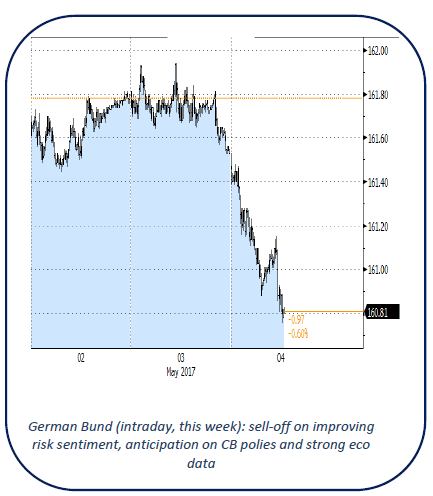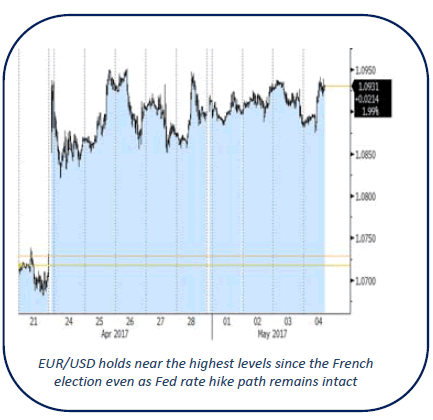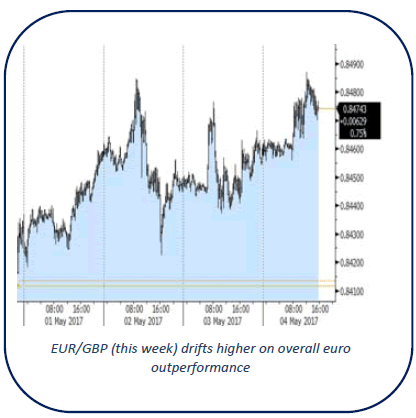Headlines
European equity markets gain up to 1% with the French CAC40 outperforming as centrist presidential candidate cleared the final (TV debate) hurdle ahead this weekend’s run off against Le Pen. US stock markets open much less enthusiastic with gains of around 0.1%.
Euro zone growth appears increasingly solid and parts of the European Central Bank’s policy guidance may change over time, ECB chief economist Praet said, reinforcing expectations for a more upbeat assessment next month.
Norway’s central bank kept its interest rates on hold (0.5%) at its latest policy meeting and plans to keep them there for the foreseeable future, adding that it will increase the frequency of its meetings and publish more information on its discussions in an effort to improve transparency around its policies.
Growth in Britain’s services sector unexpectedly strengthened in April, giving the economy a solid start to Q2 after a weaker-than-forecast performance at the start of the year. The UK services PMI increased from 55 to 55.8 while consensus expected a decline to 54.5. The final EMU services PMI was upwardly revised from 56.2 to 56.4.
Brent crude temporary dipped below the $50/barrel mark to the lowest level since November last year, virtually erasing all the gains since OPEC agreed a deal to curb supplies. The oil cartel’s attempts to reinforce the market have been hit by a quick rebound in US shale production and by signs OPEC exports have not fallen as fast as expected.
The Czech central bank kept its policy rate unchanged at 0.05% at its first policy meeting after leaving its EUR/CZK 27.00 peg. The central bank cut its CPI forecasts, but still sees "slightly inflationary" risks to them.
The US trade gap narrowed slightly in March to $43.7B, confounding expectations of a rise to $44.5B. Meanwhile, first-time jobless claims fell more than anticipated, from 257k to 238k and remain near multi-decade lows.
The European Commission proposed a draft law to continue shielding pension funds – a sector it sees as critical for investment in infrastructure – from having to clear their derivatives trades for a further three years, a move to save them billions of euros in collateral payments.
Rates
Core bonds sell off
Global core bonds lost significant ground today with German Bunds underperforming US Treasuries. At the time of writing, the German yield curve bear steepens with yields 1.4 bps (2-yr) to 7.6 bps (30-yr) higher. Changes on the US yield curve vary between +2.8 bps (2-yr) and +4.2 bps (5-yr). On intra-EMU bond markets, 10-yr yield spreads versus Germany narrowed 2 bps for core countries, up to 5 bps (France) for the semi-core and up to 10 bps for the periphery (Portugal).
The German Bund opened weaker and slid throughout the European session. Several factors played a role. First, some catching up with US Treasury losses in the wake of last night’s Fed meeting which set the stage for a June rate hike. Second, improved risk sentiment with French assets outperforming (stocks and bonds) after centrist presidential candidate Macron cleared the final (TV Debate) hurdle ahead of Sunday’s run-off against Le Pen. Third, markets anticipated (and received) more comments about the ECB’s June policy meeting. While heavyweight ECB chief economist Praet wasn’t as clear as ECB Nowotny earlier this week, he still suggested that the ECB could do something about its language at the June 8 policy meeting (changing forward guidance or risk assessment for growth). Later today, ECB President Draghi is still scheduled to speak. Fourth, similar anticipation about the balance sheet run-off by the Fed could be at play with Fed Yellen, Fischer, Williams, Rosengren, Evans and Bullard all scheduled to speak tomorrow. Fifth, eco data printed strong on both sides of the Atlantic, even if they were second tier. The balance of this week’s US eco data also suggests that tomorrow’s payrolls report will again be decent. Continued weakness of the oil price (Brent crude below $50/barrel) and commodities in general failed to stop the rod on core bond markets.
The French debt agency tapped the on the run 10-yr OAT (€3.88B 1% May2027), off the run OAT (€2.19B 2.5% May2030) and on the run 20-yr OAT (€1.93B 1.25% May2036) for a combined €8B, the upper end of the €7-8B on offer. The auction bid cover was a strong 2.11 and confirms improved demand for French OAT’s since the market-friendly outcome of the French presidential election. The Spanish treasury tapped the on the run 5-yr Bono (€1.16B 0.4% Apr2022), on the run 15-yr Obligacion (€1B 2.35% Jul2033) and two off the run bonds (€1.06B 0.75% Jul2021 & €1.48B 1.3% Oct2026). The total amount sold was near the higher bound of the eyed €4-5B with a decent auction bid cover of 1.81.

Currencies
Dollar trades mixed post-Fed. Euro outperforms
European assets maintained the lead in the risk-on trade today. This trade supported both EUR/USD, USD/JPY and EUR/JPY. So, yesterday’s Fed statement wasn’t unequivocally positive of for the dollar. EUR/USD trades in the 1.0930 area. The 1.0950 resistance remains within reach. USD/JPY extends its risk-on rebound and is challenging the 113 big figure.
Overnight, Asian stocks mostly traded in positive territory. Chinese equities again underperformed as after the Caixin manufacturing PMI, also the services PMI declined, from 52.1 to 51.2. The dollar maintained most of its post-Fed gains. EUR/USD traded around 1.0895. USD/JPY changed hands in the 112.80 area.
European equities opened strong and momentum improved further during the day. Good corporate earnings were supportive. The eco data (final PMI’s) confirmed that the European economy remains in excellent shape. EUR/USD tried a downside test early in Europe. However, the Fed keeping the door wide open for a June hike, wasn’t enough to inspire further USD gains, especially not against the euro. Interest rate differentials between the US and Germany/EMU were hardly any wider compared with pre-Fed levels. As was often the case of late, the European risk-on trade caused simultaneous gains of both USD/JPY, EUR/USD and EUR/JPY. EUR/USD rebounded to the 1.0920/40 area. EUR/JPY filled offers in the 123.60 area. Investors maybe also didn’t want to be euro short ahead of speeches from ECB’s Praet and Draghi. ECB’s Praet sounded quite upbeat on the economy, but repeated more confirmation is needed that inflation is a sustained path. The euro rally ran into resistance after the Praet comments, but the single currency maintained most of its intraday gains.
The US March trade balance was slightly smaller than expected at $43.7B. The Jobless claims declined from 257 000 to 238 000, also slightly better than expected. The impact on the dollar was limited. USD/JPY is holding near the intraday highs (113 area). EUR/USD stabilizes in the 1.0930 area. So, for now, the dollar still shows a mixed picture. In other markets, Brent oil struggles not to fall below $50/barrel. Other commodities remain also under pressure. Usually, this context is USD supportive. However, for now this trick doesn’t work, especially not for USD/EUR. Euro strength prevails.

EUR/GBP trends higher on euro strength
Sterling traded relatively calm even as there was quite some UK news with potential to move the currency. In line with the manufacturing PMI and the construction PMI, confidence in the UK services sector was also stronger than expected at 55.8 from 55.00. However, sterling didn’t profit. On the negative side for sterling, the Brexit-related bickering between the UK and the EU continued. This time discussion focused on the euro clearing in London as the EU prepares measures to gain control on this activity. However, also this sterling negative story had little impact on trading. Sterling trading mostly followed the major trends of euro strength and relative dollar softness. EUR/GBP drifted north to the high 0.84 area, supported by the rise of EUR/USD. However, a real test of the 0.85 big figure didn’t occur. The pair trades currently around 0.8475. Cable dropped temporary lower early this morning, but rebounded north of 1.29 as the dollar couldn’t maintain its post-Fed gains.














